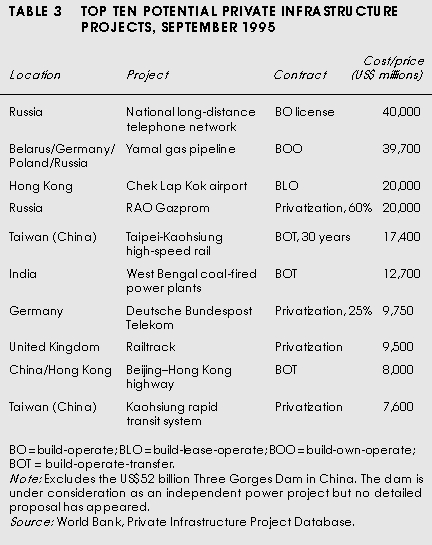
Jae So and Ben Shin
October 1995
The FPD Note series is an open forum intended to encourage dissemination and debate on ideas, innovations, and best practices relating to public policy issues in private and financial sector development. The views published are those of the authors and should not be attributed to the World Bank or any of its affiliated organizations. Nor do any of the conclusions represent official policy of the World Bank or of its Executive directors or the countries they represent.
Private infrastructure projects have boomed around the world since the 1980s, in such sectors as waste, power, water, transport, telecommunications, and natural gas. Much of this activity has its origins in the deregulation policies in the United States during the 1970s and in the privatization experiences of Chile, New Zealand, and the United Kingdom during the 1980s. These deregulation and privatization policies were driven by disenchantment with public sector performance, fiscal crises (often related), and technological changes that have increased the scope for competition. Since 1984, eighty-six countries have privatized 547 infrastructure companies, and at least 574 private greenfield infrastructure projects are under way in some eighty-two countries (see figure 1 for sectoral distribution). This Note sketches the growth of the private infrastructure industry.
Since January 1984, the value of privatizations has totaled US$357 billion and that of new investment projects more than US$308 billion. Thus, private investment activity in infrastructure amounted to some US$60 billion a year on average during the past decade. Projects averaged about US$0.6 billion in value, although about 80 percent of projects were valued at less.
Privatization activity has been dominated by sales of power companies and telecommunications companies and licenses. Sales of waste and transport companies have also been important. Greenfield investment has been most prevalent in power and transport infrastructure projects, with most transport investment going to toll roads, tunnels, and bridges. Of course, the line between privatization and greenfield investment is fluid-many newly privatized telecommunications companies invest heavily in new facilities.
Telecommunications investments tend to be funded mostly with retained earnings, reflecting strong market growth and consumers' willingness to pay for service. Many other infrastructure ventures face more uncertain financial prospects because of political difficulties in raising and regulating utility tariffs. Investors often try to manage these risks by seeking limited recourse or nonrecourse project finance.






Some geographic patterns have emerged in the past decade in private infrastructure investment. Not surprisingly, the fast-growing countries of Asia are emphasizing new investment, which accounts for more than 70 percent of the private infrastructure activity in these countries. Two countries in the region are the clear front-runners—the Philippines, with forty-four new investment projects, mostly in power, and China, with thirty-five, mostly in transport and power. Other countries with significant numbers of projects are Mexico, with fifty-four, mostly in toll roads, and the United Kingdom, with fifty-two. With 113 projects, the United States still leads overall, in large part because of its active independent power industry.
The United States also leads in privatizations, with 147. Many of these transactions are related to the recent sale of regional cellular licenses. But most privatization activity was concentrated in Latin America and OECD Europe. The United Kingdom has privatized fifty-two infrastructure companies, and Argentina forty-eight. Major privatization programs are under way in Chile and Mexico, as well as a host of privatizations, mostly in telecommunications, in countries ranging from Belize to Uruguay.
And the future? The database is tracking 2,273 potential projects—349 privatizations worth some US$480 billion and 1,924 new investment projects that could cost up to US$1,347 billion. The average size of these potential projects is about US$0.8 billion, suggesting that 75 new deals a year would keep the market at US$60 billion. That would be in line with recent trends, although new investment will probably take over from privatization as the driver of the market.
THE PRIVATE INFRASTRUCTURE PROJECT DATABASEThe database tracks private infrastructure activity in gas, power, telecommunications, transport, waste, and water since 1984. In transport, the database covers roads, railroads, airports, and ports, but excludes rolling stock and airline privatizations. It does not track waste collection contracts. The database includes information on:
The first version of this Note, which appeared in May 1995, estimated the private infrastructure market at US$30 billion. After a more intensive data gathering effort, this estimate was revised upward to US$60 billion. There are several reasons for this dramatic increase:
The database will continue to be regularly updated, and additional project information is thus actively sought. |
The first edition of this Note, issued in May 1995, was based on data collected to December 1994 in the Private Infrastructure Project Database under development in the Private Sector Development Department of the World Bank. This edition reflects data collected through early September 1995. See box on The Private Infrastructure Project Database for information on how the numbers have changed.
Jae So, Private Sector Development Specialist (email: jso@worldbank.org), and Ben Shin (email: bshin@worldbank.org), Private Sector Development Department
Comments are welcome. Please call the FPD Note line to leave a message: 202-458-1111; or contact Suzanne Smith, editor, Room G8105, The World Bank, 1818 H Street, NW, Washington, DC 20433, or at ssmith7@worldbank.org.